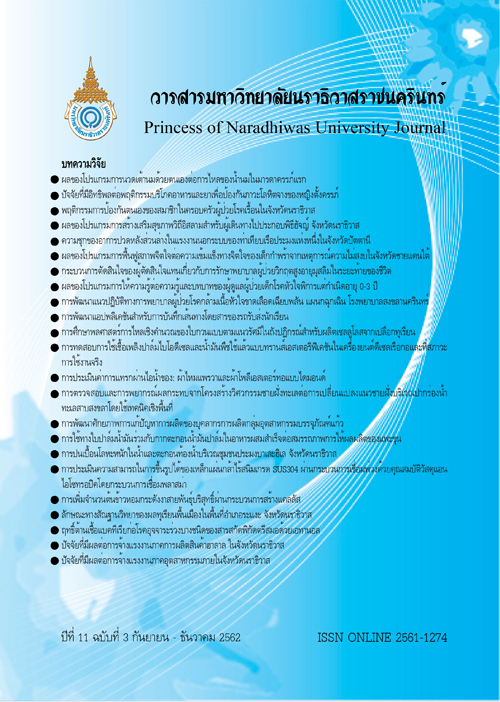Self Protective Behavior of Leprosy Family Members in Narathiwat Province
Keywords:
Preventive Behavior, Leprosy, Family MembersAbstract
This correlation research aimed toanalyze the causal relation between, in one hand, the knowledge,
attitude as well as prevention behaviortoward leprosy (exogenous latent variable)and, in the other hand,
self-protection behavior in family members of Leprosy patients (endogenous latent variable) in Narathiwat
province. The moderated mediation models were personal factors in leprosy family members: gender, age,
income, size of family as well as family type of leprosy patients. Sample was 110 family members of patients
with leprosy (15 family members of patients with leprosy more than one time, and 95 family members of
patients with leprosy only one time). The sample must live with the leprosy patient in the same home more
than 5 days a week, at least6 months, and age over 18 years old.And they were selected using the sample
criteria for multivariate analysis,as in the form of the least squares parametric equations from Hair, Hult,
Ringle, and Sarstedt (2014).
The research found that personal factors data in age and income had nostatistically significant
relationship at .05 with self-protection behaviors. The sex and size of the family and family characteristics
for self-protection behaviors were not statistically significant at the level of .05. An analysis of the causal relation between the knowledge of leprosy and attitude toward leprosy prevention behavior on self-protection behaviors found that the knowledge of leprosy was not directly affected by the leprosy behavior of leprosy family members at a statistically significant of .01.The attitudes toward leprosy had a direct influence on the leprosy prevention behavior of leprosy family members at the statistically significant level of .0.1.And
knowledge about leprosy and attitudes towards leprosy could explain the prevalence of leprosy behavior in
leprosy family members at the level of 39.4%.
References
Anuruk, Y. (2000). Health education process and health behavior development 2000. Bangkok: Sigma Graphic Design.
Benyama, N. (2007). Knowledge, understanding and practice on leprosy amon Thai Muslim patients and househol contact : case study of Rueso district, Narathiwat province. Master of Public Health. (in Thai).
Cronbach, L. J. (1963). Educational Psychology. New York :Harcourt, Brace and World.
DeeMak , N. (2004). Factors Related to Leprosy Prevention and Control Behaviors of Peoplein Sampaniang Subdistrict, Ban Phraek District, Phra Nakhon Si Ayutthaya Province. Master of Science Program in Health Education. (in Thai).
Hair, J. F., Hult, G. T. M., Ringle, C. M., & Sarstedt, M. (2014). A Primer on Partial Least Squares Structural Equation Modeling (PLS-SEM). Thousand Oaks, CA: Sage.
Morchawban. (2008). Leprosy is not as scary as you think. Retrieved9 December 2016, from https://www.doctor.or.th/article/detail/1150 (in Thai).
Petchaphum, J. (2016). Health Belief Model: HBM. Retrieved 10 November 2016, from https:// www.gotoknow.org/posts/611058
Provincial Public Health Office.,(2016). New Leprosy Patient Registration Report 2016. (in Thai).
Raj Pracha Samasai Institute. (2017). Leprosy Situation in Thailand 2017. Retrieved 7 January 2018, fromhttp://thaileprosy.ddc.moph.go.th/site/index.htm
Ringle, C. M., Wende, S., & Will, A. (2005). SmartPLS 2.0.M3. Hamburg: SmartPLS, http://www.smartpls.de., 19 July 2016.
Rosenstock, I. M. (1974). Historical origins of the Health Belief Model. Health Education Monographs. Health Education Monographs.
Serckkic, C. & Cheuin. (2014). Forecasting of leprosy by using Risk analysis Thailand, 2014. Bangkok : Raj Pracha Samasai Institute Department of Disease Control. (in Thai).
Siriudomphais, S. (2014). Leprosy. Retrieved 13 July 2016, from http://haamor.com/th/โรคเรื้อน/.
Sompoyun, S. & Aburanon, W. (1999). Health education teaching (theory and practice). Bangkok: Mind health. (in Thai).
Techaumuauywit, A. (2009). Self-Care And Factors Related To Self-Care Of Older Persons with Leprosy.
Master of Nursing Science Thesis in Gerontological Nursing, Graduated School, Khon Kaen University. (in Thai).
World Health Organization. (2018). Leprosy: world focused on ending transmission among children. Retrieved 19 July 2018, from http://www.who.int/neglected_diseases/news/Leprosy_ending_transmission_ among_children/en/.




